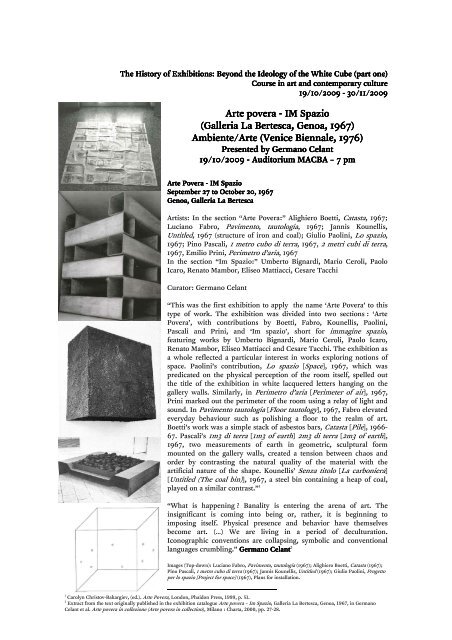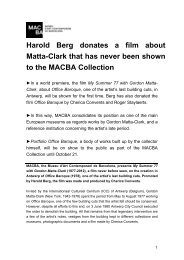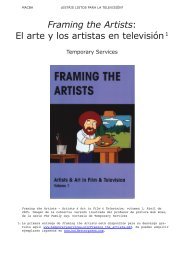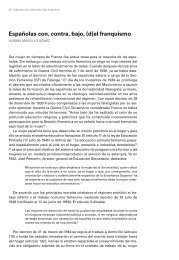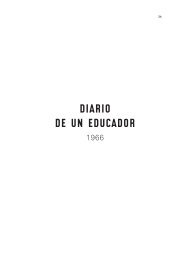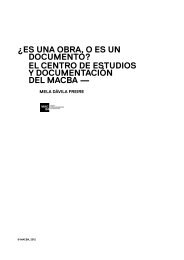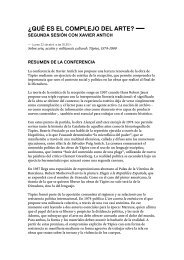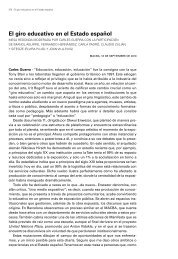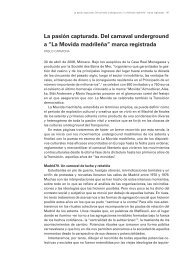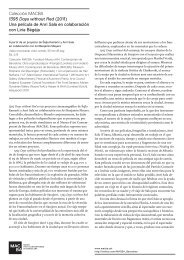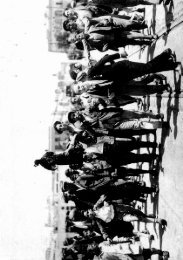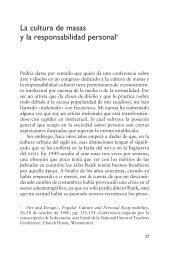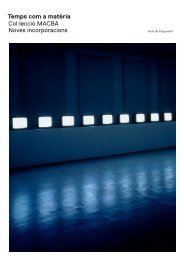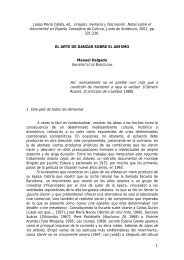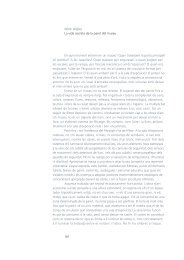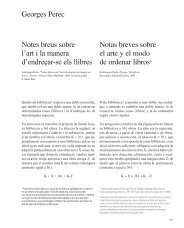Arte povera - IM Spazio IM Spazio IM Spazio (Galleria La Bertesca ...
Arte povera - IM Spazio IM Spazio IM Spazio (Galleria La Bertesca ...
Arte povera - IM Spazio IM Spazio IM Spazio (Galleria La Bertesca ...
Create successful ePaper yourself
Turn your PDF publications into a flip-book with our unique Google optimized e-Paper software.
The The History History of of Exhibitions: Exhibitions: Beyond Beyond the the Ideology Ideology of of the the White White Cube Cube (part (part one)<br />
one)<br />
Course Course in in art art and and and contemporary contemporary culture<br />
culture<br />
19/10/2009 19/10/2009 - 30/11/2009<br />
<strong>Arte</strong> <strong>Arte</strong> <strong>Arte</strong> p<strong>povera</strong><br />
p overa - <strong>IM</strong> <strong>Spazio</strong><br />
(<strong>Galleria</strong> <strong>Galleria</strong> <strong>La</strong> <strong>Bertesca</strong> <strong>Bertesca</strong>, <strong>Bertesca</strong><br />
, Geno Genoa, Geno<br />
a, 1967 1967) 1967<br />
Ambiente/ Ambiente/<strong>Arte</strong> Ambiente/ <strong>Arte</strong> (Venice Biennale, 1976)<br />
Presented Presented by by GGermano<br />
G ermano Celant<br />
Celant<br />
19/10/2009 19/10/2009 - Auditori Auditorium Auditori um MACBA – 7 7 pm<br />
pm<br />
<strong>Arte</strong> <strong>Arte</strong> Povera Povera - <strong>IM</strong> <strong>Spazio</strong><br />
September September 27 27 to to October 20, 20, 1967<br />
Genoa, Genoa, <strong>Galleria</strong> <strong>Galleria</strong> <strong>La</strong> <strong>La</strong> <strong>Bertesca</strong><br />
<strong>Bertesca</strong><br />
Artists: In the section “<strong>Arte</strong> Povera:” Alighiero Boetti, Catasta, 1967;<br />
Luciano Fabro, Pavimento, tautologia, 1967; Jannis Kounellis,<br />
Untitled, 1967 (structure of iron and coal); Giulio Paolini, Lo spazio,<br />
1967; Pino Pascali, 1 metro cubo di terra, 1967, 2 metri cubi di terra,<br />
1967, Emilio Prini, Perimetro d’aria, 1967<br />
In the section “Im <strong>Spazio</strong>:” Umberto Bignardi, Mario Ceroli, Paolo<br />
Icaro, Renato Mambor, Eliseo Mattiacci, Cesare Tacchi<br />
Curator: Germano Celant<br />
“This was the first exhibition to apply the name ‘<strong>Arte</strong> Povera’ to this<br />
type of work. The exhibition was divided into two sections : ‘<strong>Arte</strong><br />
Povera’, with contributions by Boetti, Fabro, Kounellis, Paolini,<br />
Pascali and Prini, and ‘Im spazio’, short for immagine spazio,<br />
featuring works by Umberto Bignardi, Mario Ceroli, Paolo Icaro,<br />
Renato Mambor, Eliseo Mattiacci and Cesare Tacchi. The exhibition as<br />
a whole reflected a particular interest in works exploring notions of<br />
space. Paolini’s contribution, Lo spazio [Space], 1967, which was<br />
predicated on the physical perception of the room itself, spelled out<br />
the title of the exhibition in white lacquered letters hanging on the<br />
gallery walls. Similarly, in Perimetro d’aria [Perimeter of air], 1967,<br />
Prini marked out the perimeter of the room using a relay of light and<br />
sound. In Pavimento tautologia [Floor tautology], 1967, Fabro elevated<br />
everyday behaviour such as polishing a floor to the realm of art.<br />
Boetti’s work was a simple stack of asbestos bars, Catasta [Pile], 1966-<br />
67. Pascali’s 1m3 di terra [1m3 of earth] 2m3 di terra [2m3 of earth],<br />
1967, two measurements of earth in geometric, sculptural form<br />
mounted on the gallery walls, created a tension between chaos and<br />
order by contrasting the natural quality of the material with the<br />
artificial nature of the shape. Kounellis’ Senza titolo [<strong>La</strong> carboniera]<br />
[Untitled (The coal bin)], 1967, a steel bin containing a heap of coal,<br />
played on a similar contrast.” 1<br />
“What is happening ? Banality is entering the arena of art. The<br />
insignificant is coming into being or, rather, it is beginning to<br />
imposing itself. Physical presence and behavior have themselves<br />
become art. (…) We are living in a period of deculturation.<br />
Iconographic conventions are collapsing, symbolic and conventional<br />
languages crumbling.” Germano Germano Germano Celant Celant<br />
2<br />
Images (Top-down): Luciano Fabro, Pavimento, tautologia (1967); Alighiero Boetti, Catasta (1967);<br />
Pino Pascali, 1 metro cubo di terra (1967); Jannis Kounellis, Untitled (1967); Giulio Paolini, Progetto<br />
per lo spazio [Project for space] (1967), Plans for installation.<br />
1 Carolyn Christov-Bakargiev, (ed.). <strong>Arte</strong> Povera, London, Phaidon Press, 1999, p. 51.<br />
2 Extract from the text originally published in the exhibition catalogue <strong>Arte</strong> <strong>povera</strong> – Im <strong>Spazio</strong>, <strong>Galleria</strong> <strong>La</strong> <strong>Bertesca</strong>, Genoa, 1967, in Germano<br />
Celant et al. <strong>Arte</strong> <strong>povera</strong> in collezione (<strong>Arte</strong> <strong>povera</strong> in collection), Milano : Charta, 2000, pp. 27-28.
Ambiente/ Ambiente/<strong>Arte</strong><br />
Ambiente/ Ambiente/ <strong>Arte</strong><br />
July July 18 18 18 to to October October October 10, 10, 10, 1976 1976<br />
1976<br />
XXXVIIe XXXVIIe XXXVIIe Venice Venice Biennale, Biennale, Italy<br />
Italy<br />
Total attendance of the 1976 Venice Biennale: 692 000<br />
1976 Venice Biennale’s general theme was<br />
“Ambiente, Partecipazione, Strutture Culturali”<br />
(Environment, Participation, Cultural Structures).<br />
Germano Celant’s exhibition Ambiente/<strong>Arte</strong> was<br />
located in the Central Pavilion and comprised a<br />
historical and a contemporary section. In the<br />
contemporary section, he commissioned artists such<br />
as Vito Acconci, Michael Asher, Daniel Buren, Mario<br />
Merz and Dan Graham to interact with the indoor<br />
architecture of the Giardini. In the historical section,<br />
he reconstructed avant-garde and post-war<br />
environments called “ambiente”. Some<br />
reconstructions were made specifically for the<br />
biennale such as Man Ray’s Exit (1934), Yves Klein’s<br />
Immaterieller Raum (1961) and Arman’s Le plein<br />
(1960) which kept its original facade. The Jackson<br />
Pollock room did not include real Pollock paintings,<br />
it was an environment which gave a sense of<br />
Pollock’s way of working: there was six<br />
photographic enlargements of Pollock at work by<br />
Hans Namuth (1950), a life-size enlargement on the<br />
floor of One, number 31 (1950) and Namuth’s film<br />
on Pollock. The concept of “ambiente” should be<br />
understood in relationship with Celant’s passionate<br />
interest in the history of avant-garde installation 3<br />
which led him to reflect on the context as integral to<br />
the work. In Ambiente/<strong>Arte</strong>, the context referred to<br />
the interior architecture, the internal structure of<br />
the space, its volume and surface. According to him,<br />
although mosaics and frescoes had already paved the<br />
way for such an assimilation, the historical avantgarde<br />
in the 1910s and 1920s produced<br />
environments whose integration of space into the<br />
work had become actively part of the creative process.<br />
Artists and exhibitions : 1. Balla, Depero, Pannaggi,<br />
Tatlin-Yakulov, Rodchenko, Puni, Lissitsky, De<br />
Pisis. 2. Kandinsky, Davis, Delaunay, Vordemberge-<br />
Gildewart, Burchartz, Huszar, Mondrian, Van<br />
Doesburg, Tauber-Arp, Schlemmer, Gorin,<br />
Strzeminsky. 3. Van Doesburg, Dada-Messe,<br />
Duchamp, Schwitters. 4. Arp, Radice, Sartoris,<br />
Gorin, Duchamp, Ray, Surrealist Exhibitions<br />
1938/1942/1947, Pollock, Fontana, Gallizio, Klein,<br />
Kaprow. 5. Nevelson, Klein, Manzoni, Arman,<br />
Segal, Kaprow, Oldenburg, Ben, Watts. 6. Christo,<br />
Oldenburg, Paolini, Colombo, Schneeman, Accardi,<br />
Warhol, Pistoletto. 7. Information 1966/1976.<br />
8. Palermo. 9. Buren. 10. Graham. 11. Beuys. 12.<br />
LeWitt. 13. Merz. 14. Nauman. 15. Kounellis. 16.<br />
Acconci . 17. Irwin. 18. Nordman. 19. Wheeler. 20.<br />
Asher<br />
Curator : Germano Celant<br />
3 Celant, Germano, ‘A visual machine: art installation and its modern archetypes’ in GREENBERG, Reesa; FERGUSON, Brunce W.; NAIRNE,<br />
Sandy. Thinking about Exhibitions, London: Routledge, 1996
“At the start of the twentieth century, within an artistic system that is directed towards objectivity, both<br />
in surface and in volume, the possibilities of an “ambient” choice were extremely limited. The artist<br />
was tied by the demand which urged him to operate on the monolithic scale of the picture and the<br />
sculpture and had few occasions to exceed the confines of the ambient space, defined by 4 walls, the<br />
ceiling and the floor. The uneasiness and intolerance caused by this conditioned situation, in which the<br />
object, from being only one of the many forms of art, had become the sole vehicle of expression,<br />
exploded from 1909 with the comprehensive vision of Futurism. This urged linguistic and physical<br />
movements beyond previous limits and opened a free procedural space from the strictly visual<br />
monopoly. (...) The aim is that of creating a field in space and time to make a “unicum”, where art<br />
bears witness to vital, ideological needs, and to physically and aesthetically<br />
integrate the existence of art with the concrete reality<br />
which surrounds it.” Germano Celant Celant 4<br />
Germano Germano Celant<br />
Celant<br />
Germano Celant, PhD in Contemporary Art and Theory, is internationally acknowledged for his<br />
theories on <strong>Arte</strong> Povera. He is the curator of hundreds of exhibitions in the most prominent<br />
international museums and institutions worldwide. Additionally, he is author of more than one<br />
hundred publications, including both books and catalogues. Since 1977 he has been a contributing<br />
editor to “Artforum”, in New York. In 1987 he received The Frank Jewett Mather Award from CAA,<br />
The College Art Association of America. Since 1989 till 2008 he has been the Senior Curator of<br />
Contemporary Art at the Solomon R. Guggenheim Museum, in New York. In 1997 he was appointed<br />
Curator of the 47. Esposizione Internazionale d'<strong>Arte</strong>. <strong>La</strong> Biennale di Venezia. Since 1995 he is the<br />
Director of Fondazione Prada, Milan. In 2001 he curated the Brazilian Pavillon at the 49. Esposizione<br />
Internazionale d'<strong>Arte</strong>, Venice. Since 2005 he is the Director of Fondazione Aldo Rossi, Milan and since<br />
2008 he is the Curator of the Fondazione Annabianca e Emilio Vedova, Venice. Since 2009 he is the<br />
Curator of Art and Architecture at <strong>La</strong> Triennale di Milano, Milan.<br />
Since 1970 Celant has organized exhibitions and art events such as Conceptual Art <strong>Arte</strong> Povera <strong>La</strong>nd<br />
Art, the Civic Museum, Turin 1970; Ambiente/<strong>Arte</strong>, the Venice Biennale, 1976; Identité italienne,<br />
Centre Georges Pompidou, Paris 1981. He co-directed Documenta 7, Kassel 1982 and together with<br />
Pontus Hulten he organized Futurismo & Futurismi, Palazzo Grassi, Venice 1986 and <strong>Arte</strong> italiana<br />
1900-1945, Palazzo Grassi, Venice 1989; with Norman Rosenthal Italian Art in the XXth Century, the<br />
Royal Academy, London 1989; with Ida Gianelli Memoria del futuro, Centro de <strong>Arte</strong> Reina Sofia,<br />
Madrid, 1990; The Italian Metamorphosis 1943-1968, The Solomon R. Guggenheim Museum, 1994;<br />
Brazil, Body & Soul, The Solomon R. Guggenheim Museum, 2001; Unveiling the Prada Foundation,<br />
with OMA/Rem Koolhaas, Fondazione Prada, Milan, 2008.<br />
Since 1971, he has been curating major anthological one-man exhibitions for artists such as: Joseph<br />
Beuys, Naples, 1971; Jannis Kounellis, Rimini, 1983; Mario Merz, New York, 1989; Ugo Mulas, Milan,<br />
1989; Robert Mapplethorpe (first european retrospective), Stockholm, 1992 ; Rebecca Horn, The<br />
Solomon R. Guggenheim Museum, 1993; Keith Haring, Rivoli, 1994; Claes Oldenburg, Washington,<br />
1996; Andy Warhol: A Factory, Kunstmuseum, Wolfsburg, 1998; Kunsthalle, Wien; Palais des Beaux<br />
Arts, Bruxelles; Guggenheim Museum, Bilbao, 1999; <strong>La</strong>urie Anderson, Fondazione Prada, Milan, 1998;<br />
Merce Cunningham, Fondació Tápies, Barcelona; Museu Serralves, Porto, 1999; con Clare Bell, Jim<br />
Dine, The Solomon R. Guggenheim Museum, New York, 1999; Mariko Mori. Dream Temple,<br />
Fondazione Prada, Milan, 1999; Thomas Demand. Processo grottesco, Fondazione Giorgio Cini,<br />
Venice, 2007; Natalie Djurberg. Turn into me, Fondazione Prada, Milan, 2008; Manzoni. A<br />
Retrospective, Gagosian Gallery, New York, 2009; John Wesley, Fondazione Prada, Venice, 2009.<br />
4 Germano Celant, Art & Environment 1909-2009. Sculpturing the interior space.
Selected Selected bibliography<br />
bibliography<br />
<strong>Arte</strong> <strong>povera</strong>, 1966-1980 : libri e documenti, Mantova : Corraini, 2007<br />
ALLOWAY, <strong>La</strong>wrence. The Venice Biennale 1895-1969. From Salon to Goldfish Bowl. Connecticut:<br />
New York Graphic Society, 1968<br />
CELANT, Germano. <strong>Arte</strong> Povera – Im <strong>Spazio</strong>, Genoa: Masnata/Trentalance, 1967<br />
CELANT, Germano. Ambiente/<strong>Arte</strong>: dal futurismo alla body art. Venezia: <strong>La</strong> Biennale di Venezia, 1977<br />
CELANT, Germano. ‘Ambient/Art’ in Environment, Participation, Cultural Structures (first volume),<br />
Venice: <strong>La</strong> Biennale di Venezia, 1976<br />
CELANT, Germano. “Notes for a guerrilla war”, Flash Art, n.5, 1967<br />
http://www.flashartonline.com/interno.php?pagina=articolo_det&id_art=352&det=ok&title=ARTE-<br />
POVERA<br />
CELANT, Germano. <strong>Arte</strong> <strong>povera</strong>, Milano: Gabriele Mazzotta, 1969<br />
CELANT, Germano. <strong>Arte</strong> <strong>povera</strong> : 13 italienische Künstler, Dokumentation und neue Werke, München:<br />
Kunstverein München, 1971<br />
CELANT, Germano. <strong>Arte</strong> <strong>povera</strong>. Milano: Umberto Allemandi & C., 1989<br />
CELANT, Germano. <strong>Arte</strong> <strong>povera</strong>. Milano: Electa, 1985<br />
CELANT, Germano. Identité italienne : l'art en Italie depuis 1959, Paris: Centre Pompidou, 1981<br />
CELANT, Germano, SZEEMANN, Harald; TRINI Tommaso; AMMANN Jean-Christophe. <strong>Arte</strong> <strong>povera</strong><br />
in collezione (<strong>Arte</strong> <strong>povera</strong> in collection), Milano: Charta, cop. 2000<br />
CELANT, Germano. « A Visual Machine : Art installation and its modern archetypes, in GREENBERG,<br />
Reesa; FERGUSON, Brunce W.; NAIRNE, Sandy. Thinking about Exhibitions, London: Routledge,<br />
1996<br />
CHRISTOV-BAKARGIEV (ed.). <strong>Arte</strong> Povera, London: Phaidon Press, 1999<br />
DI MARTINO Enzo; RIZZI Paolo. Storia della Biennale, 1895-1982, Milano: Electa, c1982.<br />
DI MARTINO, Enzo. <strong>La</strong> Biennale di Venezia: 1895-1995: cento anni di arte e cultura. Milano: Giorgio<br />
Mondadori, 1995.<br />
MORRIS Frances ; FLOOD Richard, Zero to Infinity: <strong>Arte</strong> Povera 1962-1972, Tate Modern Londres,<br />
Walker Art Center Minneapolis, 2001<br />
POLANCO, Aurora Fernández. <strong>Arte</strong> <strong>povera</strong>, Nerea: DL 1999<br />
References of images : MORRIS Frances ; FLOOD Richard, Zero to Infinity: <strong>Arte</strong> Povera 1962-1972,<br />
Tate Modern Londres, Walker Art Center Minneapolis, 2001; CELANT, Germano. Identité italienne :<br />
l'art en Italie depuis 1959, Paris, Centre Pompidou, 1981 ; CHRISTOV-BAKARGIEV (ed.). <strong>Arte</strong> Povera,<br />
London, Phaidon Press, 1999 ; CELANT, Germano. ‘Ambient/Art’ in Environment, Participation,<br />
Cultural Structures (first volume), Venice: <strong>La</strong> Biennale di Venezia, 1976<br />
Document edited by Florence Ostende


